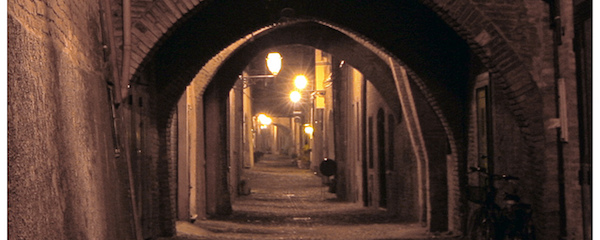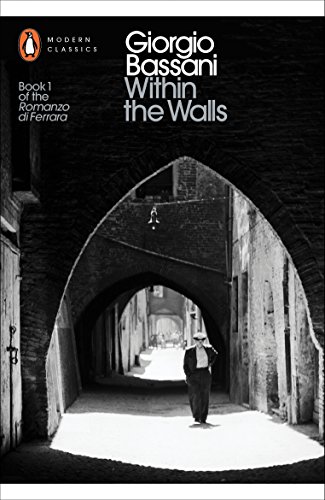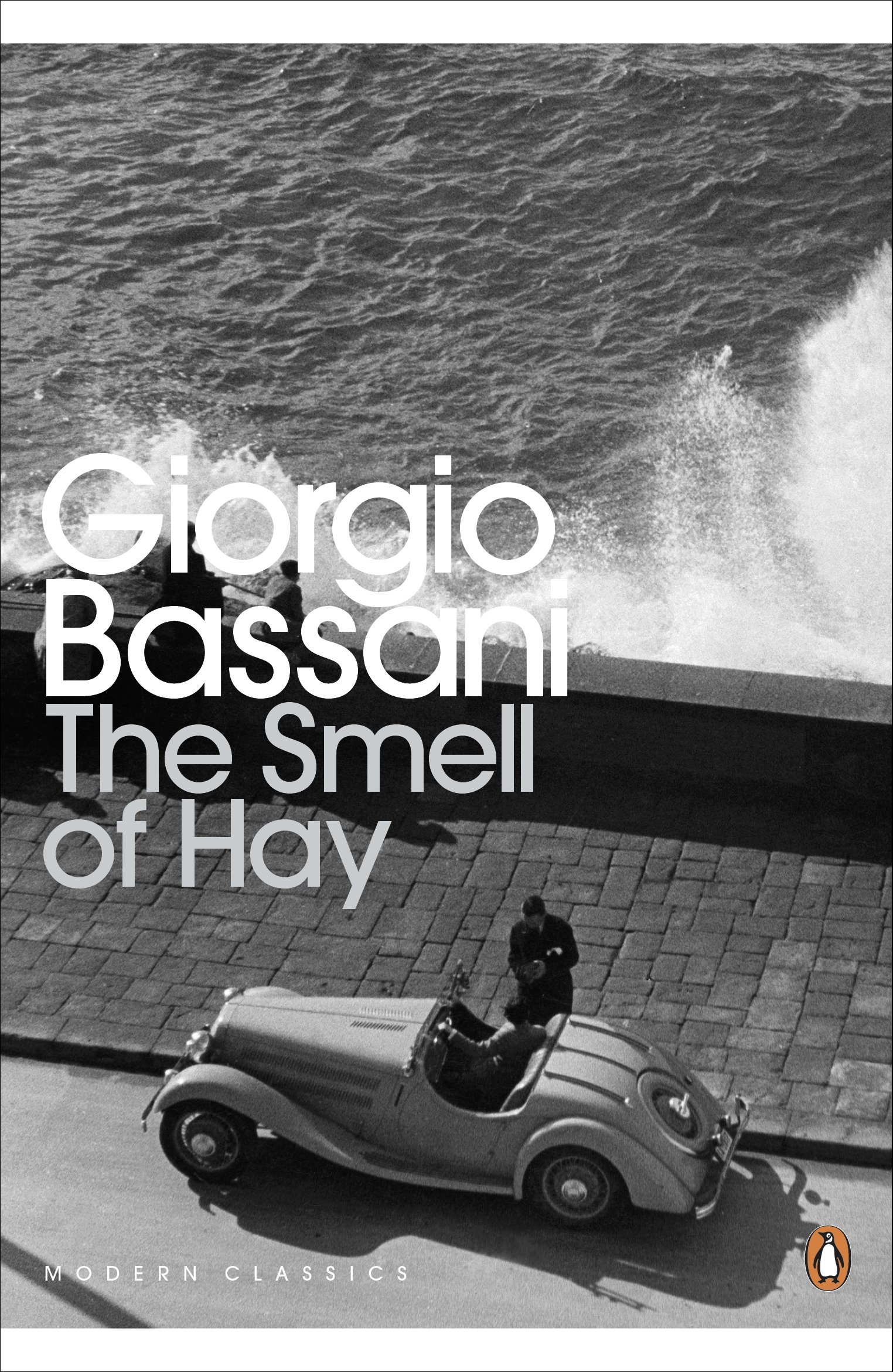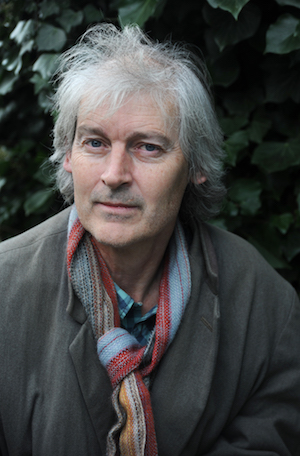
('Ferrara storica di notte' © mauro_ventura, 2011)
*
STEPHANIE NORGATE INTERVIEWS JAMIE McKENDRICK,
poet and translator, on his translation of Georgio Bassani’s
short story collection Within the Walls.
*
Jamie’s other translations of Bassani’s work are: The Smell of Hay (short story collection), and Bassani’s novels, The Garden of the Finzi-Continis and The Gold-Rimmed Spectacles, all for Penguin Classics. Behind the Door and The Heron are also soon to be published by Penguin Modern Classics.
~
 Giorgio Bassani (1916-2000) was born in Bologna to a Jewish family, and lived in Ferrara where he attended school. He then studied in the Faculty of Arts at the University of Bologna. After graduation, he became involved in anti-Fascist activities which resulted in imprisonment in 1943. Released after Mussolini’s temporary fall, he moved to Florence with his wife Valeria to live under assumed names. During the Salò Republic (1943-1945), many relatives and neighbours from Ferrara were transported to the Buchenwald death camps. After the war, Bassani brought up his family in Rome, where he worked as a teacher, a translator, and as a scriptwriter for films by Antonioni and Soldati. He became editor of international literary magazine Botteghe Oscure and then fiction editor at Feltrinelli where he published the previously rejected novel The Leopard by Giuseppe di Lampedusa (1956). Later he was vice-president of RAI television network and, in 1965, became president of ‘Italia Nostra’, a national heritage organisation.
Giorgio Bassani (1916-2000) was born in Bologna to a Jewish family, and lived in Ferrara where he attended school. He then studied in the Faculty of Arts at the University of Bologna. After graduation, he became involved in anti-Fascist activities which resulted in imprisonment in 1943. Released after Mussolini’s temporary fall, he moved to Florence with his wife Valeria to live under assumed names. During the Salò Republic (1943-1945), many relatives and neighbours from Ferrara were transported to the Buchenwald death camps. After the war, Bassani brought up his family in Rome, where he worked as a teacher, a translator, and as a scriptwriter for films by Antonioni and Soldati. He became editor of international literary magazine Botteghe Oscure and then fiction editor at Feltrinelli where he published the previously rejected novel The Leopard by Giuseppe di Lampedusa (1956). Later he was vice-president of RAI television network and, in 1965, became president of ‘Italia Nostra’, a national heritage organisation.
Bassani began by writing poetry and always considered himself a poet. He also wrote prize-winning novels, short stories, screenplays and essays. His short story collection, first published as Cinque storie ferrarese (five stories of Ferrara) won the 1956 Strega Prize, was republished later under the title, Within the Walls. His acclaimed novel, The Garden of the Finzi-Continis, was made into a film by renowned director, Vittorio de Sica in 1970. His short stories and novels, set in Ferrara, were collected and published as Il Romanzo di Ferrara (the novel of Ferrara) in 1974.
~
THE INTERVIEW
~
Stephanie Norgate: Jamie, welcome to Thresholds. Many thanks for agreeing to an interview on your translation of Georgio Bassani’s 1956 collection, Within the Walls (Penguin Classics, 2016). You’ve also translated another of Bassani’s short story collections, The Smell of Hay. What first attracted you to his short stories? And could you tell us a little about the historic context and emotional territory of the collection under discussion, Within the Walls? Are these early or late stories by Bassani?
Jamie McKendrick: I was first drawn to Bassani’s work by his novella The Gold-Rimmed Spectacles which, with The Garden of the Finzi-Continis, seemed to me his masterpieces. It was really only by working on his two short story collections, but most especially Within the Walls, that I began to see not only his skill as a short story writer but also how crucial that first collection is to the entire project which was to be gathered together under the title of Il romanzo di Ferrara.
Bassani had tried out some of these stories in an earlier gathering, and it cost him a great labour to finalise the form of these stories which would become the first book of the subsequent sequence. In an epilogue to his collection The Smell of Hay, he gives an intriguing account of the arduous process of writing these first stories, interspersed with bicycle rides.
The stories are all set in the walled city of Ferrara and yet cover a wider period than the rest of his fiction starting with ‘A Stroll before Dinner’ which I take to be around the turn of the last century and ending with the post-war reconstruction. Still they inexorably move towards the Fascist years which would become the focus of both The Garden and The Gold-Rimmed Spectacles.
 SN: And which is your favourite of the five stories here? And why?
SN: And which is your favourite of the five stories here? And why?
JM: In The Smell of Hay the best story, for me, is ‘Further News of Bruno Lattes’ which relates very closely to ‘The Last Days of Clelia Trotti’, the longest and most diffuse of the stories in Within the Walls, but still perhaps the one that most intrigues me for its acute sense of both time and place but also for the murky dissatisfied consciousness of its protagonist, Bruno. The first story ‘Lida Mantovani’ which I began by liking least in the end more than converted me. At first I found it tedious and claustrophobic but then realised it was a study in tedium and was subtly expansive. I find it hard to weigh the merits of these five stories, having been won over by each of them. Each earns its place in the quincunx, at the heart of which is the final story, ‘A Night in 1943’, arguably the most achieved of them all.
SN: Within the Walls is a short story collection, yet each of the five stories operates at length and is split into small chapters, with four, six or nine sections. Is there any sense that each short story in the collection is like a mini-novel?
JM: The chaptering of Bassani’s short stories is remarkably consistent with that of his novels, with some minimal variation in length. It’s as though these formal units, from the start of his writing career, were the shapes he was accustomed to thinking in. He’s essentially a writer of short fiction, with the exception of The Garden which isn’t even that long a novel. And yet even his short stories have a slow, deliberate, massy development. The long sentences with dependent clauses and embedded parentheses are another consistent stylistic feature that has the effect of slowing up time.
SN: Is the order of the stories in Within the Walls important?
JM: If I’m not mistaken the collection is not chronological, as I take the second story ‘A Stroll before Supper’ to precede the first, but those stories have a concealed symmetry. In ‘Lida Mantovani’, Davide, a well-off Jew, gets a Christian girl pregnant and then disappears from her life and from the narrative, to be replaced by the middle-aged and somewhat bigotted bookbinder Orestes (a figure who very gradually indeed begins to earn our sympathy). In the second story, the same thing occurs but the doctor, Elia Corcos, after anxious vacillation, marries the girl Gemma and remains at the heart of the story (though here it is unexpectedly Gemma’s sister who becomes increasingly central). But beyond these curious parallels the stories have an inward circling which brings them ever closer to the disaster that befell both the Jewish community as well as the whole city of Ferrara – from the Racial Laws of 1938 to the deportations of 1943 – five years that are the temporal epicentre of Bassani’s fiction.
SN: Would you see the stories as a ‘short story cycle’, ‘sequence’ or ‘composite novel’? In what ways do they weave together the story of a time as well as of a place?
*
Although the stories of Within the Walls
are both various and intimately related,
they represent the opening act
of what would become a larger cycle
*
JM: Although the stories of Within the Walls are both various and intimately related, they represent the opening act of what would become a larger cycle, the entire six-book work, Il romanzo di Ferrara. Though the interconnectedness of this whole cycle, the overlapping characters and interwoven themes, may only have become apparent to Bassani later on, and still, I think, each of the books can satisfyingly be read as free-standing, these first stories have a crucial annunciatory status within the whole work as well as being superbly achieved in themselves.
SN: Could you comment on Bassani’s use of free indirect style to inhabit various viewpoints? Were these shifting points of view within a first-person narrative difficult to render in English? Sometimes he talks about ‘to us’ or ‘we’ – and I wondered whose voice he is inhabiting here?
JM: There’s a choric element to this: a chorus of reasonable, seemingly well-meaning citizens. ‘A Memorial Tablet in Via Mazzini’ is a good example. As with ‘A Night in ’43’, and especially the first chapters of The Gold-Rimmed Spectacles, it is as if the city itself is given a voice – gossipy and, progressively, insinuating and prejudicial. And so the citizens’ incomprehension about Geo Josz’s behaviour, the gradual hardening of their hearts towards this survivor of the death camps, reaches by slow degrees a pitch of denunciation. The free indirect style of narrative, in all these instances, begins by lulling the reader into a sense of pleasant normality and complicity which then becomes disturbing, even incriminating.
SN: I was particularly struck by ‘A Memorial Tablet in Via Mazzini’, and how the citizens of Ferrara are happy with a memorial tablet to the inhabitants of Ferrara killed in the holocaust but not so comfortable with the actual survivor of Buchenwald who returns to live among them. How does Bassani, in the aftermath of what historian and former partisan Claudio Pavone calls Italy’s ‘civil war’, attend to themes of memory and forgetting in the stories?
JM: Bassani is indeed obsessed with memory and his response towards forgetting seems to be unforgiving. That story begins with the installation of the plaque on the synagogue wall by a peasant boy who has no interest in or knowledge of its contents. Throughout the whole Romanzo there are such memorials – cemeteries, tombstones, and in this collection, the plaque by the castle for the citizens shot by the Fascist squad, the First World War tablet in the school and so on, which serve as pious forms of public memory. Bassani himself is the memorious chronicler of this historic period and, in his way, as inconvenient and unwelcome as Geo Josz. He too is a survivor, if not of the camps, of his largely destroyed community, whereas his fellow citizens are bent on forgetting the trauma and resuming their lives, though the stories are more nuanced than this bald account would suggest.
SN: The way each story focalised problems of Fascism in the microcosm of Ferrara, really struck me. For instance, ‘The Night of ’43’ seems to embody something of the way in which Fascism operated to draw the individual in through peer pressure. Does Bassani punish Pino for his silence through the events of the story? How are fears about fidelity in marriage played out against the tensions of bearing witness?
JM: There is some ambiguity about the motives behind Pino’s refusal to implicate the Fascist squad leader Sciagura (Calamity) in the trial, but it seems most likely that his silence is based not on complicity but on the desire to protect his unfaithful wife’s reputation, and possibly his own. His silence thwarts whatever hope there is of achieving justice let alone reconciliation within post-war Ferrara. Yet in his eccentric way, Pino continues to bear witness by haranguing unsuspecting tourists who pass by beneath the chemist’s window, paying scant attention to the plaque that commemorates the massacre.
SN: I read that Bruno Lattes is often seen as the alter-ego character in the short stories, and he also appears in the other short story collection, The Smell of Hay. Did you see Bruno Lattes as another Bassani? I read that he had a friendship with a character similar to Clelia Trotti?
*
Bruno is a recurrent character and may
indeed represent an element of Bassani himself
– wounded, hounded, resentful, excluded
*
JM: The unnamed narrator of The Garden, of The Gold-Rimmed Spectacles and of Behind the Door clearly has a better or more obvious claim to be Bassani’s alter-ego, his narrative stand-in. But Bruno is a recurrent character within the stories and novels and may indeed represent an element of Bassani himself – wounded, hounded, resentful, excluded. I’m slightly resistant to speculating on Bassani’s psychological closeness to his characters but I think it’s also a natural urge for the reader to identify the novelist with his creations.
 SN: I enjoyed your translation of Bassani’s ‘Towards Ferrara’ in The Faber Book of 20th-Century Italian Poems, which you also edited. You are a poet and Bassani was a poet as well as fiction writer. Do you think Bassani’s prose in the short stories shows his roots in poetry? Do you think the stories work in an associative way as poems so often do?
SN: I enjoyed your translation of Bassani’s ‘Towards Ferrara’ in The Faber Book of 20th-Century Italian Poems, which you also edited. You are a poet and Bassani was a poet as well as fiction writer. Do you think Bassani’s prose in the short stories shows his roots in poetry? Do you think the stories work in an associative way as poems so often do?
JM: Bassani in several interviews insists on being primarily a poet. He started as a poet and continued as one. I’m inclined to see a demarcation between the poetry and prose though there are undoubtedly overlaps, for example the atmosphere of the train journey in the lyrical ‘Towards Ferrara’ and his descriptions of the students travelling back and forth to Bologna in the early chapters of The Gold-Rimmed Spectacles. There are many other striking parallels right through the Romanzo with his poems. However these are not repetitions but are made distinct from one another by the contrasting demands of the different forms.
SN: Finally, if you were recommending Bassani’s short stories to a new reader, how would you summarise his strengths and appeal as a writer of short fiction? Which book of Bassani’s would you suggest as a starting point for new readers of his work?
JM: Bassani’s short stories ‘book-end’ his prose works – Within the Walls begins and The Smell of Hay ends his Romanzo. The first is an ouverture to the whole work, but also remarkably complete in itself. It stakes out his territory with extraordinary sureness and courage for a young writer. Even stylistically, as I’ve suggested earlier, it has his unmistakeable signature. We think of the short story as something of a sprint, or at least as a form needing to shed the inessential. What is peculiar about Bassani is how slow and massive the movement of his prose is, just as much in the short stories as in his novels. This collection is the ideal place to start with his work, but I began as a reader, as well as a translator, with The Garden and The Gold-Rimmed Spectacles, and that seemed to work just as well.
The Smell of Hay has a very different character. With the exception of a couple of stories, it is more sketchy and fugitive, a shade closer to journalism, and yet freighted with the stylistic sophistication of a lifetime of writing. These stories too very much earn a place in the overall architecture of his work, although I’d say it would be a collection better read at the end.
SN: Jamie, thank you so much for this rich and fascinating interview on Bassani’s work. I’m looking forward to reading your new translations of Bassani’s Behind the Door and The Heron, when they come out with Penguin Classics.
~
 Jamie McKendrick (born in Liverpool in 1955) is the author of six collections of poetry, including The Marble Fly (1997), winner of the Forward Prize for Best Collection and a Poetry Book Society Choice; Ink Stone (2003), shortlisted for the T. S. Eliot Prize and the Whitbread Poetry Award; and Crocodiles & Obelisks, shortlisted for the Forward Prize. Out There (2012) won the Hawthornden Prize. An earlier selection of his poems was published as Sky Nails (2000), and he is editor of 20th-Century Italian Poems (2004). The Embrace, his translations of Valerio Magrelli’s poetry, won the Oxford-Weidenfeld and the John Florio prizes. His translation of a selection of Antonella Anedda’s poems, Archipelago, also won the John Florio prize. In 2016, Jamie McKendrick’s Selected Poems was published by Faber & Faber.
Jamie McKendrick (born in Liverpool in 1955) is the author of six collections of poetry, including The Marble Fly (1997), winner of the Forward Prize for Best Collection and a Poetry Book Society Choice; Ink Stone (2003), shortlisted for the T. S. Eliot Prize and the Whitbread Poetry Award; and Crocodiles & Obelisks, shortlisted for the Forward Prize. Out There (2012) won the Hawthornden Prize. An earlier selection of his poems was published as Sky Nails (2000), and he is editor of 20th-Century Italian Poems (2004). The Embrace, his translations of Valerio Magrelli’s poetry, won the Oxford-Weidenfeld and the John Florio prizes. His translation of a selection of Antonella Anedda’s poems, Archipelago, also won the John Florio prize. In 2016, Jamie McKendrick’s Selected Poems was published by Faber & Faber.
~
 Stephanie Norgate is a Reader in Creative Writing at the University of Chichester. Her two collections of poetry from Bloodaxe are Hidden River (2008, shortlisted for the Forward First Collection Prize and the Jerwood Aldeburgh prize) and The Blue Den (2012). Her plays have been broadcast on BBC Radio 4. She is currently completing a novel set in Northern Italy during the time of Mussolini’s Salò Republic.
Stephanie Norgate is a Reader in Creative Writing at the University of Chichester. Her two collections of poetry from Bloodaxe are Hidden River (2008, shortlisted for the Forward First Collection Prize and the Jerwood Aldeburgh prize) and The Blue Den (2012). Her plays have been broadcast on BBC Radio 4. She is currently completing a novel set in Northern Italy during the time of Mussolini’s Salò Republic.
Save

